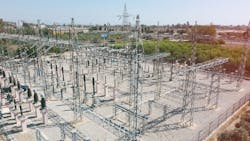The Contribution of T&D Systems and SF6 Alternatives to a Carbon-Neutral Future
The International Energy Agency’s recently published Roadmap to Net Zero calls for immediate action to reduce carbon emissions by 2050. We know the pathway requires electrification of transport, industry, and buildings and will be primarily driven by renewable energy sources like wind and solar. But while decarbonizing power generation is vital, transmission and distribution (T&D) systems must also contribute to the energy transition.
On average, power from a wind farm travels five times the distance compared to conventional energy sources. This greater distance means the power has to pass through more substations which calls for grid expansion and higher reliability to ensure the security of power supply. Reliability of equipment is the most crucial contribution of T&D equipment to the energy transition.
One may ask, should the equipment that is used to transmit and distribute the renewable power also be carbon-optimal? For almost half a century, sulfur hexafluoride (SF6) has been the gas of choice in high-voltage equipment due to its excellent insulation and switching properties. Its use, however, can affect the environment. As a greenhouse gas, SF6 is approximately 23,000 times stronger than CO2 and lasts in the atmosphere for 3200 years. Latest state-of-the-art T&D equipment can offer impressive levels of tightness, however, if there is leakage, SF6 does contribute to global warming.
As the sense of urgency rises, utilities look at every aspect of the energy value chain to cut emissions. This includes replacing SF6 whenever possible. An ideal solution should retain the best of SF6: compact size, scalability to all voltage levels, and the predictable and soft switching character of gas circuit-breakers. Utilities also call on the vendors to converge towards one common SF6 replacement gas because this allows them to train their personnel once.
Thinking High Voltage
After decades of research, fluoronitrile-based gas mixtures are emerging as the common technology to eliminate SF6. They are effective in high-voltage insulation and switching and hundred times better from a global warming perspective, essentially eliminating the carbon footprint of the insulation gas.
The key advantage of the fluoronitrile-based solutions is the similarity to SF6 in size, scalability and application to all required duties including inductive loads and capacitor banks. All this while keeping the same safety margins essential for reliable high-voltage transmission. This move is happening sooner than you may think as the fluoronitrile-based high-voltage portfolios are about to be extended to the transmission level.
Some hesitate to embrace fluoronitrile-based gas mixtures on the grounds that their carbon footprint is not absolutely zero neglecting the fact that an optimum gas needs to balance multiple properties. Another approach to SF6 elimination in high-voltage equipment uses technical air for the gas insulation plus vacuum breakers for switching.
Vacuum technology is — for good reasons, the most common solution in medium-voltage. However, this experience cannot be extrapolated to the high-voltage level as the vacuum insulation is not increasing linearly with the gap distance but tends to saturate. Additionally, vacuum insulation and interruption have significantly stronger random character. These characteristics of vacuum technology limit its scalability.
Some switching events of vacuum breakers like current chopping of inductive loads or restrikes when switching capacitor banks impose significant risk upon neighboring equipment. The higher the voltage level, the higher the risk. The use of technical air implies bigger equipment, which results in a larger overall carbon footprint, defeating the intent of the shift. Furthermore, the condition of gas circuit-breakers can be monitored and inspected, enabling operators to make informed choice concerning the condition of their equipment.
Collaborating Toward an Industry Standard
Responsible decisions and collaboration across company boundaries have always been characteristic for the power industry. They are also needed now. A common alternative gas solution offered by multiple vendors provides economy of scale and positive network effects. Utilities can use the same gas handling equipment, gas monitoring sensors, and training programs for operating staff with the new gas solution. This move toward a standard solution makes it as easy as possible for utilities to switch to a more sustainable gas.
Developing an industry-standard also opens doors for further innovation within the sector. As more laws on SF6 are arising, such as in California and Massachusetts which set a 1% limit to SF6 leakage, utilities can collaborate around the common technology and fine-tune the practical usage of these gases.
With the window of opportunity to avoid the worst effects of climate change rapidly closing, we must leave no stone unturned in our effort to dramatically reduce emissions. Utilities must act now to identify the right alternatives, embrace new ways of thinking and collaboration that support our carbon-neutral energy future.
